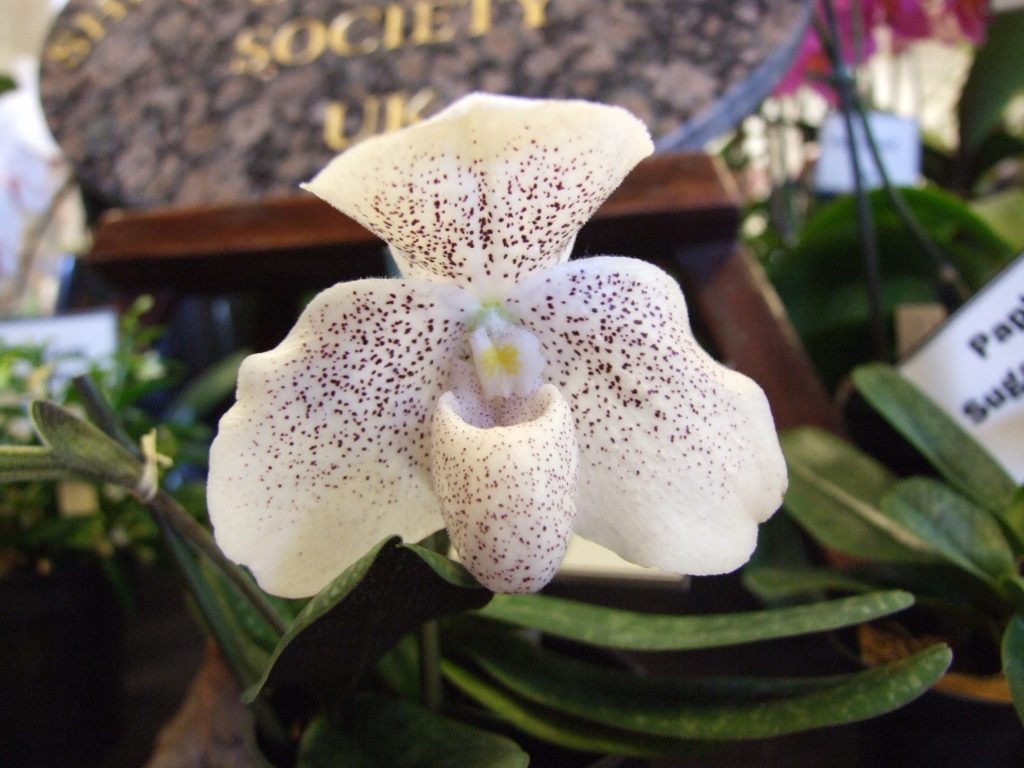Sheffield & District Orchid Society

Paphiopedilum species come from subtropical areas of Southeast Asia and are essentially humus epiphytes rather than terrestrials which has significant implications for their culture either in a greenhouse or in the home. They are a diverse genus of orchids with a widespread geographic range, from the mountains of the Himalayas to the steaming jungles of Borneo, so any cultural advice can only be given in general terms. It is important to obtain as much information as possible about habitat conditions of individual species. Understanding the recent parentage of some of the hybrids will be useful in ensuring optimum culture of these truly exotic plants.
Growing Media or Compost: Experienced growers experiment with a range of composts; for the novice a good quality bark based compost will give the best chance of success. A good quality mix is as follows: 60% good quality medium grade fir bark, 20% large perlite or sponge rock, 10% medium grade horticultural foam, 10% good quality sphagnum moss. Additionally crushed dolomite lime can be added at the rate of one teaspoon per litre of compost
Potting and Re-potting: If plants are purchased in pots, then it is important to check the quality of the root system relative to the size of the pot. Gently ease the plant out of the pot, retaining as much of the compost as possible around the roots. Where the plant comes easily out of the pot with only a few roots being evident then it is likely that the plant has been over potted, and it should be transferred to a smaller pot without delay and kept a little drier for a few weeks until evidence of new root growth becomes apparent. Paphiopedilums should never be overpotted, and it is important to err on the side of caution when selecting the correct size of pot. Clear pots are now available which enables growers to monitor root development more easily. Re-potting should normally be required every 2 years but other cultural factors such as feeding regimes could affect the re-potting cycle. Watering, Water Quality and Feeding: Preferably use rainwater or Reverse Osmosis water (RO) with a pH approaching neutral for Paphiopedilums. Tap water should only be used where the dissolved salts are very low otherwise the plants will
not thrive. It is important that a balanced fertilizer is used with the necessary trace elements for good healthy growth. There are many balanced fertilizers on the market for orchids, however those fertilizers with high levels of urea should be avoided as it is difficult for orchids to take up this type of nitrogen.
Watering should normally take place early in the day and plants should always be kept moist and never be allowed to become dry at the roots. Paphiopedilums have no mechanisms for storing water other than plant tissue including roots. Frequency of watering will depend on
cultural conditions: usually once a week for mature plants, however plants in smaller pots may need watering every other day.
Light levels/Shading: Paphiopedilums should never be subjected to direct sunlight, but good quality indirect light is essential to achieve optimum growth and regular flowering. If growing in a greenhouse 60% shade cloth should normally be applied in February and remain in place until late September depending on location and presence of large overhanging trees. In the home, plants can be placed in a north facing window all year round. Paphiopedilums can benefit from additional artificial lighting either to extend the day or provide better quality light during the darker months of the year. There are many different types of artificial lighting on the
market. Grow Lux tubes with the correct spectrum for plant growth and flowering have become very popular in recent years.
Heating, Temperature Control & Ventilation: Paphiopedilums generally thrive within an average temperature range from a minimum of 14°C in winter to 30°C in summer depending on where they come from in the wild. Consequently, growers usually divide their plants into intermediate and warm sections to facilitate optimum growth. Temperatures are usually controlled by good quality electronic thermostats and efficient ventilation in summer. Plants can benefit from air movement and ventilation fans are useful in creating a gently breeze throughout the growing area.
Humidity: Humidity levels in the range of 70% are vital in order to grow good quality Paphiopedilums. This can be maintained by a variety of methods such as foggers or sprayers. For individual plants grown in the home gravel trays can be useful to provide local humidity, however care should be taken to avoid placing plants near to radiators.
Pests & Diseases: Fortunately, there are few pests which are a problem for Paphiopedilums with the exception of mealy bug which can be difficult to eradicate if well-established within a large collection. In this case regular spraying with a systemic insecticide will be necessary; however, preventing these pests entering the growing area in the first place is the preferred option. For individual plants several applications of methylated spirits applied by a toothbrush usually has the desired effect.
Disease on Paphiopedilums is of much more concern as bacterial or fungal infections can quickly spread throughout a collection. Prompt attention to control the spread of the disease is important by removal of infected leaves and spraying of affected areas with a good quality fungicide. Cinnamon is extremely useful in treating localised areas of rot. Flowering: Flowering will normally occur when a plant has at least 2 mature growths and has completed the latest growth. Flower spikes should be staked as soon as possible to avoid kinking so that the flowers are presented in the correct attitude. It is important not to tie the opening flower too early otherwise it may hang its head. When exhibiting plants it is important to ensure the foliage is clean and healthy with any detritus and decaying leaves removed.